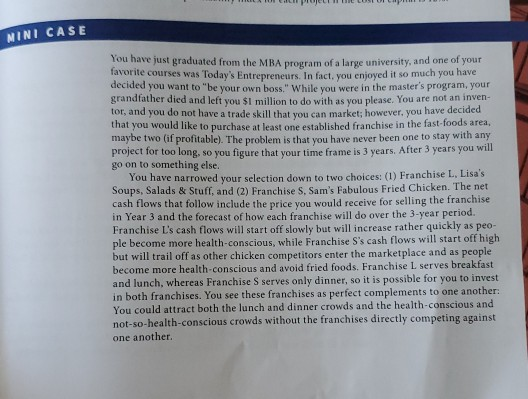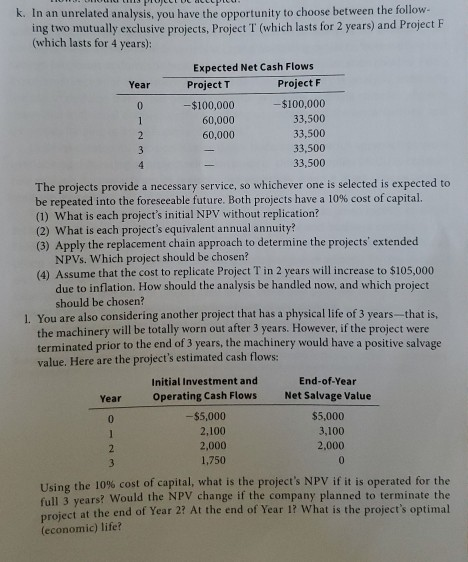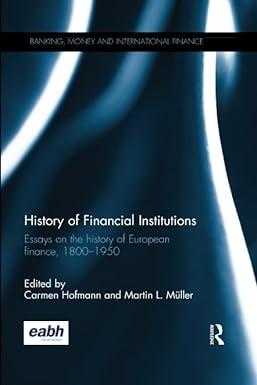Answered step by step
Verified Expert Solution
Question
1 Approved Answer
NINI CASE You have just graduated from the MBA program of a large university, and one of your favorite courses was Today's Entrepreneurs. In fact,


NINI CASE You have just graduated from the MBA program of a large university, and one of your favorite courses was Today's Entrepreneurs. In fact, you enjoyed it so much you have decided you want to be your own boss." While you were in the master's program, your grandfather died and left you $1 million to do with as you please. You are not an inven- tor, and you do not have a trade skill that you can market; however, you have decided that you would like to purchase at least one established franchise in the fast-foods area. maybe two of profitable). The problem is that you have never been one to stay with any project for too long, so you figure that your time frame is 3 years. After 3 years you will go on to something else. You have narrowed your selection down to two choices: (1) Franchise L. Lisa's Soups, Salads & Stuff, and (2) Franchise S. Sam's Fabulous Fried Chicken. The net cash flows that follow include the price you would receive for selling the franchise in Year 3 and the forecast of how each franchise will do over the 3-year period. Franchise L's cash flows will start off slowly but will increase rather quickly as peo- ple become more health-conscious, while Franchise S's cash flows will start off high but will trail off as other chicken competitors enter the marketplace and as people become more health-conscious and avoid fried foods. Franchise I serves breakfast and lunch, whereas Franchise S serves only dinner, so it is possible for you to invest in both franchises. You see these franchises as perfect complements to one another: You could attract both the lunch and dinner crowds and the health-conscious and not-so-health-conscious crowds without the franchises directly competing against one another. 0 k. In an unrelated analysis, you have the opportunity to choose between the follow- ing two mutually exclusive projects, Project T (which lasts for 2 years) and Project F (which lasts for 4 years): Expected Net Cash Flows Year Project T Project F -$100,000 -$100,000 1 60,000 33,500 2 60,000 33,500 3 33,500 33,500 The projects provide a necessary service, so whichever one is selected is expected to be repeated into the foreseeable future. Both projects have a 10% cost of capital. (1) What is each project's initial NPV without replication? (2) What is each project's equivalent annual annuity? (3) Apply the replacement chain approach to determine the projects' extended NPVs. Which project should be chosen? (4) Assume that the cost to replicate Project Tin 2 years will increase to $105,000 due to inflation. How should the analysis be handled now, and which project should be chosen? 1. You are also considering another project that has a physical life of 3 years--that is, the machinery will be totally worn out after 3 years. However, if the project were terminated prior to the end of 3 years, the machinery would have a positive salvage value. Here are the project's estimated cash flows: Initial Investment and End-of-Year Year Operating Cash Flows Net Salvage Value -$5,000 $5,000 2,100 3,100 2 2,000 2,000 3 1,750 Using the 10% cost of capital, what is the project's NPV if it is operated for the full 3 years? Would the NPV change if the company planned to terminate the project at the end of Year 2? At the end of Year I? What is the project's optimal (economic) life? 0 0
Step by Step Solution
There are 3 Steps involved in it
Step: 1

Get Instant Access to Expert-Tailored Solutions
See step-by-step solutions with expert insights and AI powered tools for academic success
Step: 2

Step: 3

Ace Your Homework with AI
Get the answers you need in no time with our AI-driven, step-by-step assistance
Get Started


